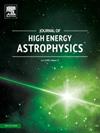A New Master Supernovae Ia sample and the investigation of the Hubble tension
IF 10.5
4区 物理与天体物理
Q1 ASTRONOMY & ASTROPHYSICS
引用次数: 0
Abstract
Modern cosmological research still thoroughly debates the discrepancy between local probes and the Cosmic Microwave Background observations in the Hubble constant () measurements, ranging from 4 to 6σ. In the current study, we examine this tension using the Supernovae Ia (SNe Ia) data from the Pantheon, Pantheon+ (P+), Joint Lightcurve Analysis (JLA), and Dark Energy Survey, (DES) catalogs combined together into the so-called Master Sample. The sample contains 3714 SNe Ia, and is divided all of them into redshift-ordered bins. Three binning techniques are presented: the equi-population, the moving window (MW), and the equi-spacing in the . We perform a Markov-Chain Monte Carlo analysis (MCMC) for each bin to determine the value, estimating it within the standard flat ΛCDM and the CDM models. These values are then fitted with the following phenomenological function: , where is a free parameter representing fitted in , and α is the evolutionary parameter. Our results indicate a decreasing trend characterized by , whose consistency with zero ranges from 1σ in 5 cases to 1 case at 3 σ and 11 cases at in several samples and configurations. Such a trend in the SNe Ia catalogs could be due to evolution with redshift for the astrophysical variables or unveiled selection biases. Alternatively, intrinsic physics, possibly the theory of gravity, could be responsible for this trend.
一个新的主超新星Ia样本和哈勃张力的研究
现代宇宙学研究仍然在彻底争论局部探测器和宇宙微波背景观测在哈勃常数(H0)测量上的差异,范围从4到6σ。在目前的研究中,我们使用来自万神殿,万神殿+ (P+),联合光曲线分析(JLA)和暗能量调查(DES)目录的Ia超新星(SNe Ia)数据来检查这种张力,这些数据组合在一起成为所谓的主样本。样本包含3714个snia,并将它们全部划分为红移有序的bins。提出了三种分簇技术:等总体、移动窗口(MW)和log (z)的等间距。我们对每个桶执行马尔可夫链蒙特卡罗分析(MCMC)以确定H0值,并在标准平面ΛCDM和w0waCDM模型中进行估计。然后用以下现象学函数拟合这些H0值:H0(z)=H ~ 0/(1+z)α,其中H ~ 0是表示在z=0中拟合的H0(z)的自由参数,α是进化参数。结果表明,在若干样品和构型中,其与零的一致性范围为α ~ 0.01,从5个样品的1σ到1个样品的3σ和11个样品的>;3σ。超新星Ia星表中的这种趋势可能是由于天体物理变量的红移进化或揭示的选择偏差。或者,内在物理学,可能是引力的f(R)理论,可能是造成这种趋势的原因。
本文章由计算机程序翻译,如有差异,请以英文原文为准。
求助全文
约1分钟内获得全文
求助全文
来源期刊

Journal of High Energy Astrophysics
Earth and Planetary Sciences-Space and Planetary Science
CiteScore
9.70
自引率
5.30%
发文量
38
审稿时长
65 days
期刊介绍:
The journal welcomes manuscripts on theoretical models, simulations, and observations of highly energetic astrophysical objects both in our Galaxy and beyond. Among those, black holes at all scales, neutron stars, pulsars and their nebula, binaries, novae and supernovae, their remnants, active galaxies, and clusters are just a few examples. The journal will consider research across the whole electromagnetic spectrum, as well as research using various messengers, such as gravitational waves or neutrinos. Effects of high-energy phenomena on cosmology and star-formation, results from dedicated surveys expanding the knowledge of extreme environments, and astrophysical implications of dark matter are also welcomed topics.
 求助内容:
求助内容: 应助结果提醒方式:
应助结果提醒方式:


